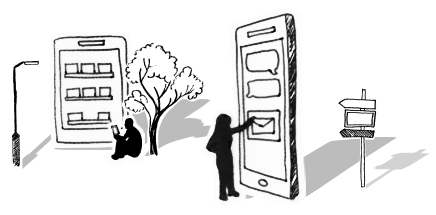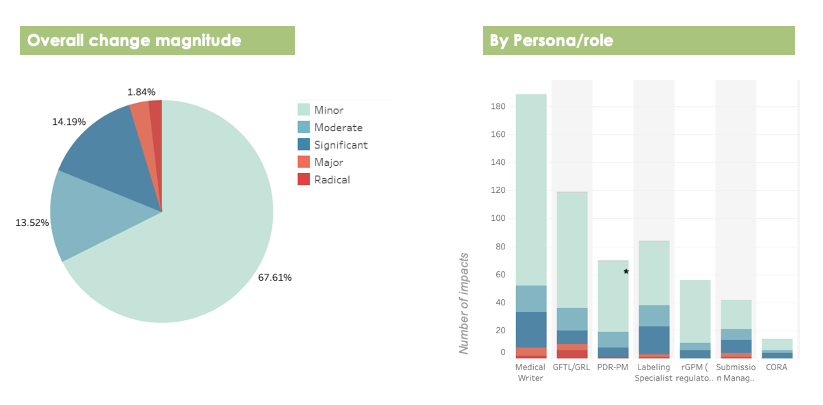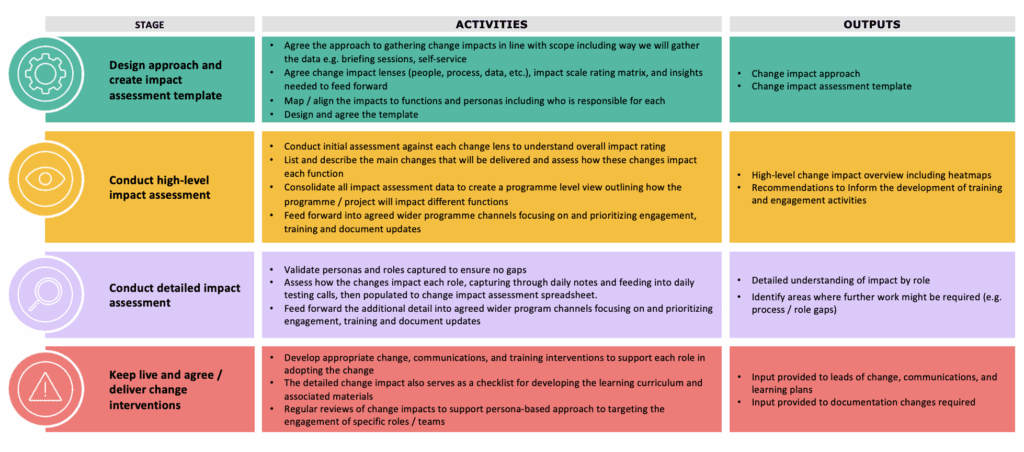




The Importance of Change Impact Assessments
Regardless of the type of change being deployed in an organisation, the change impact assessment (CIA) is a critical activity that will contribute towards making change stick.
Impacted stakeholders want to understand “What’s in it for me?”, and the change impact assessment uncovers this information and supports the planning of change interventions that will increase the probability of project success.
Read on to find out:
- What a change impact assessment is and when to conduct one
- The benefits of change impact analysis
- The different types of change impact and analysis
- Best practices and key questions for a change impact assessment
- What to do with the findings of your change impact analysis
- Whether you should use a change impact assessment template
- A step-by-step guide on how to conduct a change impact assessment
- A real-world case study of a change impact assessment
Are you ready for change?
To find out if your organisation is ready for change, use our free online change readiness assessment tool to identify your strengths and gaps in the 6 key Levers for successful change
What is a change impact assessment and what are the benefits?
Your change impact assessment will analyse the type and level of change expected to impact groups of employees. It is used to understand how people will be impacted and will therefore inform and shape your change strategy.
Carrying out a change impact assessment will enable you to spend time on the right activities for informing, engaging and equipping people to adapt when they need to.
Identifying and communicating what’s changing at the right time prepares people and allows them the opportunity to process what the change will look like for them. This can lead to:
- Increased speed of adoption, utilisation and proficiency with regard to the new ways of working
- Reduced hidden costs, such as the need to retrain people who haven’t bought into the change at an early stage
- Building internal change capability by coaching the client to start thinking through a change lens, enabling them to better manage future change initiatives on their own
- Ultimately reducing the risk of change failure and maximising the chances of benefits realisation
Introduction to Change Impact Assessments
Afiniti partner Anthony Edwards gives an overview of change impact assessments and key considerations when conducting them.
When should you conduct a change impact assessment?
A change impact assessment should be carried out during the early planning stages of your business change, before any delivery or rollout has started. If you don’t understand how your change will impact various stakeholder groups, it will be impossible to create targeted and effective interventions to bring them on the change journey, which will significantly harm your progress and results.
What are the different types of change impact?
Your change will impact in different ways depending on the scale and scope of your project and your organisation. However, change impacts can be broadly grouped into these categories:
Systems and Tools
Changes that require new technologies, updates to existing tools or shifts in how systems are accessed or integrated.
Processes
Modifications to workflows, procedures, or how tasks are executed across teams or functions.
Org Design
Impacts to team structures, reporting lines, or departmental roles that may require reorganization.
Skill Impact
Gaps in capabilities or the need for new training to meet revised expectations or operate new systems.
Culture/Behaviours
Shifts in mindset, values, or daily work habits that may challenge existing norms or team dynamics.
Responsibilities
Changes in who does what — roles may expand, contract, or transfer, often requiring negotiation and clarification.
Your change initiative might cause one or a combination of these impacts, but you won’t fully uncover this until you engage stakeholders directly with a change impact assessment.
What are the different types, techniques or models of change impact assessment?
To properly assess the full scope of a change, different types of change impact analysis can be used, each focusing on a specific dimension of the organisation. Whether the change is structural, technological, or behavioural, applying the right lens helps ensure no critical impact is overlooked.
Business Change Impact Analysis
Helps you identify the specific groups, departments, functions, teams, and job roles that will be affected by the change.
System or Software Change Impact Analysis
Enables you to pinpoint which business processes and legacy technology tools will be impacted, or potentially replaced, by a technology-driven change.
Cultural, Mindset or Operational Change Impact Analysis
Allows you to identify the individuals and groups whose behaviours, attitudes or ways of working will be affected, so they can be supported through the transition.
Your change impact analysis needs to measure potential change impact across a range of categories, including people, process, technology, culture and competency. Therefore, it should be quantifiable so it can be measured, compared and benchmarked. Use scales of 1-5, 6 or 10 to assess the level of change, with standard descriptions for each number so anyone participating or reading the results can understand the scores. As specialists in the people agenda of change, we use scales of 1-25 to enable us to get the granularity needed to truly focus on people, roles and functions.
What are best practices for carrying out a change impact assessment?
Firstly, always speak to the people who are going to be affected to get a true understanding of change impact; don’t just rely on project team members or sponsors for your data. You need the ground-level insights, not just the enterprise helicopter view, as this is where the impacts will be felt the most.
Though you should use numbers to standardise your scores, numbers alone generally aren’t enough; the detail behind your scoring is really essential, so get as much insight as you can.
The method you use to gather data will influence this. You can use a survey if necessary, but ideally you should have a detailed discussion with impacted colleagues. Or, even better, do it in a workshop with people moving around the room and contributing to various activities and questions at the same time.
Key Questions to Ask During a Change Impact Assessment
- Which business units or departments will be affected by the change?
- Where are these teams located? (Are they based in a single location or spread across multiple sites, regions, or countries?)
- Does the change introduce new technology, systems, or digital tools?
- How will roles and responsibilities be affected? (Will roles be redefined, created, or made redundant?)
- Will new skills or capabilities be required for the change to succeed?
- Will individuals need to adopt new mindsets, behaviours, or ways of working?
- Which business processes will change, and how significant are these changes?
- Are there any compliance, legal, or regulatory implications associated with the change?
- How will the change impact external clients, customers or suppliers?
- What level of communication and training will be required to support the change?
- Will there be short-term increases in workload or disruptions to daily operations?
- Who are the key stakeholders or sponsors, and what level of engagement will be needed?
- What risks or resistance might emerge, and how can they be mitigated?
How should I address the findings of my change impact analysis?
Once you’ve interpreted the data, you can bring it to life for your people with visual tables, graphs, etc.

Use techniques like impact analysis to assess the severity and reach of each change, dependency mapping to understand how impacts are linked across systems, roles, or processes, and gap analysis to highlight the difference between the current and future state — especially where new skills, behaviours, or tools are required.
Look for patterns in responses and see if you can tell an engaging story from these.
But also, crucially, pick out concerns or challenges identified and use your project team and subject matter experts to directly assess them and devise ways to address them as a team.
The change tactics you develop should be designed to help mitigate and manage the impact you’ve identified.
Should I use a change impact assessment template?
Templates can be useful, but because every change is different, your approach to measuring change impact should be tailored to what you’re really trying to understand and measure.
For this reason, Afiniti doesn’t recommend or rely on a change impact assessment template. If you need any help designing an assessment that’s bespoke to your change, let us know.
How to Conduct a Change Impact Assessment
The following steps outline how to carry out a Change Impact Assessment in a structured and practical way. Starting with scoping and stakeholder identification, and progressing through data collection, impact analysis and intervention planning, this approach ensures you gather the right insights and translate them into clear, targeted actions.

1. Decide the Scope and Identify Key Stakeholders
Start by defining the boundaries of the change and identifying who needs to be involved.
Activities:
- Clarify what is changing (e.g., technology, process, structure).
- Conduct a stakeholder analysis to identify impacted business units, functions and roles.
- Establish which stakeholder groups will need to provide insights or be engaged throughout the process.
Output:
- Defined scope and stakeholder map
2. Gather Current State Information and Map to the Future State
Understand how things work today and what’s changing.
Activities:
- Collect process documentation, job descriptions, org charts, and system usage info.
- Define the “to-be” state based on the change objectives.
- Create gap analyses to highlight the differences between current and future states.
Output:
- Current vs future state mapping
- High-level impact overview
This stage marks the transition from high-level impact assessment to detailed impact analysis.
3. Conduct Feedback Collection via Stakeholder Engagement
Engage the people closest to the work to validate assumptions and uncover real-world impacts.
Methods:
- Interviews – One-on-one discussions to gather in-depth insights into how individuals and teams will be affected.
- Workshops – Collaborative sessions with groups to map impacts, validate gaps, and co-create solutions.
- Surveys – Scalable tools for collecting input from larger audiences on anticipated challenges, concerns, or support needs.
Output:
- Detailed stakeholder input
- Nuanced view of change impacts across functions and geographies
4. Analyse the Impacts and Prioritise
Classify and rate the change impacts to inform planning.
Activities:
- Categorise each impact by area: systems/tools, processes, roles, skills, behaviours, and culture.
- Rate each impact as High, Medium, or Low based on severity and scope.
- Identify key pain points or resistance risks.
Output:
- Prioritised impact list
- Impact heat map or matrix
5. Define and Assign Change Interventions
Tailor your change management response based on the level and type of impact.
Activities:
For each identified impact, plan and assign appropriate interventions such as:
- Leadership coaching – Support leaders to guide their teams through the change.
- Change network – Mobilise local champions to drive adoption and gather feedback.
- Communications – Deliver targeted messages to build awareness and understanding.
- Training – Provide learning support to address skill gaps and enable new ways of working.
- Resistance management – Address pushback through proactive engagement and listening.
Output:
- Actionable change intervention plan
- Ownership assigned by role or team
By following these steps, you move from understanding the broad scope of change to identifying specific impacts and assigning the right responses. This process enables you to plan change interventions based on real data, helping affected teams navigate the transition with clarity, support and minimal disruption.
A Change Impact Assessment Case Study
Project Overview
A global energy company investing in a connected SAP ERP solution to harmonise their global ways of working engaged Afiniti as the business change partner to support the UK Business Unit.

Our Change Impact Assessment Solution
High-Level Change Impact Analysis
Initially we supported the client to identify and assess impacts across the dimensions of process, people, organisation, systems and data at a high-level.
The high-level change impact assessment represented the average magnitude of change across functional business areas. This was a great tool to support initial communication and engagement with impacted stakeholders and allowed for the change management team to be correctly resourced for the next stage of the project.
There was still much work to be done to uncover what change would look like for specific teams and roles, but the high-level change impact assessment provided the baseline to progress to more detailed change impact assessments.
Detailed Change Impact Analysis
Working in partnership with the client team to uncover the change impacts at the individual role level, we:
- Drew on the client’s technical and process knowledge and experience of their business areas
- Reviewed project artefacts, such as process design documents
- Conducted workshops to consider the technical input from a people perspective
The detailed change impact analysis was captured and baselined in a change workbook, which was the single source of truth for all change management related data and was regularly updated throughout the life of the project.
The value our change impact analysis added
1. The foundation of the change interventions
The change impact assessments formed the basis of what we needed to communicate, inform and educate people on to support the successful transition from the current to future ways of working. The change impact analysis supported the delivery of a number of interventions, including:
- Raising initial awareness about the project – highlighting the main changes across the organisation
- Building the learning curriculum and developing course materials.
- Establishing an adoption network, bringing together a community of change champions to support their business areas through the change.
The impact assessments determined the roles that were built into personas, providing input to change impact workshops to bring the changes to life for highly impacted roles before attending training. The data captured in the assessments also provided important input into future targeted messages.
By understanding the change impacts, we were able to identify and reach out to teams and roles facing radical and major change to see how they currently felt about the transition.
We ensured these managers and teams were added to the stakeholder engagement plan so that we could continue to support these individuals in their change journey. We continued to monitor highly impacted teams to identify change resistance and change fatigue.
3. Identifying gaps in the current project deliverables
An inadvertent benefit of the impact assessments for this client was identifying gaps in solution and process design; we uncovered over twenty changes that could not yet be assessed due to:
- Unfinished design and build across SAP S4/HANA and integrated systems
- Lack of direction/ agreement regarding the organisation’s future processes and ways of working.
The project team subsequently progressed these to completion in readiness for finalising the baselined impacts.
4. Focusing the client on thinking about change from the individual perspective
Ultimately, the impact assessments enabled the client team to begin to really think about benefits and challenges at both the functional and the individual level.
The focus moved from emphasising the benefits the project would bring for the organisation to looking at it from a people perspective.
As a result, we had an engaged client team who understood the importance of putting people at the front of centre of everything they do.
Learn more about how we can help your organisation with its SAP S/4HANA business change challenges and opportunities, or alternatively get in touch for support with the change impact assessment for your next project.
Frequently Asked Change Impact Assessment Questions
A change impact assessment (CIA) is a structured process used to identify how a proposed change will affect people, processes, systems, roles and behaviours within an organisation. It helps teams understand the scope and scale of impact, so they can prepare targeted support strategies to manage the transition effectively.
Conducting a change impact assessment helps reduce resistance, avoid costly delays and improve adoption of change initiatives. It enables better decision-making by highlighting potential risks, affected stakeholders and areas that need training, communication, or support.
Key steps in a change impact assessment include:
- Defining the scope and identifying stakeholders
- Mapping current and future states
- Gathering input via interviews, workshops and surveys
- Analysing the type and severity of impacts
- Categorising impacts and planning change interventions
- Validating findings with stakeholders
- Integrating results into the change management plan
Skipping a change impact assessment can lead to poor communication, resistance to change, missed training needs, reduced productivity and project delays. It also increases the risk of change failure due to unanticipated people or process impacts.
A change impact assessment should be performed early in the change lifecycle, typically after the change is defined but before implementation. It may also be revisited during delivery to reflect evolving impacts as plans become clearer.
Stakeholders typically include change managers, project leads, HR, department heads, subject matter experts and impacted end-users. Their input ensures a well-rounded view of how the change will affect various parts of the organisation.
Common tools include stakeholder maps, impact rating matrices, current vs. future state maps and impact tracking spreadsheets. Many organisations also use survey tools or workshop guides to gather input efficiently.
A change impact assessment provides the foundation for targeted communication, training and engagement strategies. It ensures change management efforts are focused on the areas of highest impact and greatest need, improving readiness and adoption.
To get the latest change tips, advice and guidance directly to your inbox, sign up to our monthly Business Change Digest.

